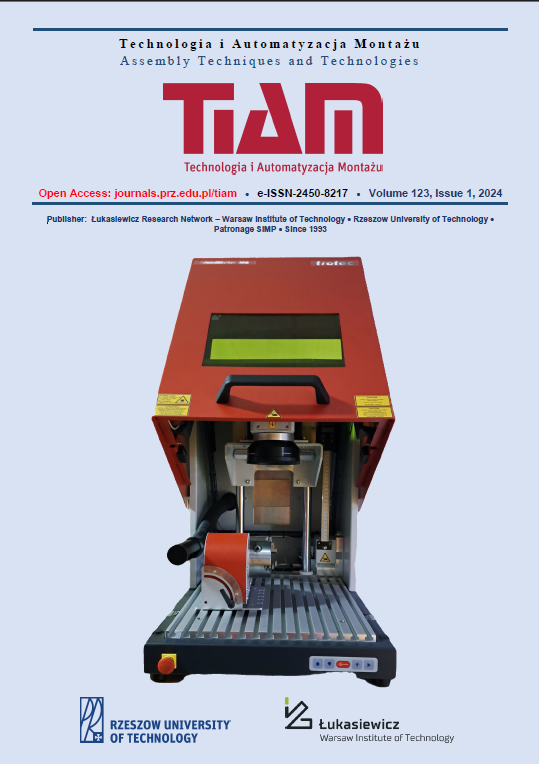Abstract
Sign language represents an efficient way for individuals with hearing impairments to communicate. We propose a sign recognition system into which several tools are integrated to help with the image pre-processing part. By doing so, a machine learning model was developed that does not require a lot of processing power because instead of using the images themselves, it uses extracted data from them to connect this model to a mobile interface that the users will use to recognise signed letters successfully. The communication between the client and the model is sustained through a local server. Introducing sign language into assembly processes is not only a gesture of respect for diversity and inclusion but also a strategic decision that brings tangible benefits. It improves communication, safety, employee morale and overall efficiency, an essential element in achieving operational excellence and an integrated workplace.
References
Adithya V. and Rajesh R.. 2020. A deep convolutional neural network approach for static hand gesture recognition. Procedia Comput. Sci. 171 (2020), 2353–2361.
ALTA (2024). Deaf culture and sign language. https://www.altalang.com/beyond-words/deaf-culture-and-sign-language/
Assael, Y. M., Shillingford, B., Whiteson, S., & de Freitas, N. (2016). LipNet: Sentence-level Lipreading. Computing Research Repository (CoRR), 1611.01599, 1-13.
http://arxiv.org/abs/1611.01599
Bhavsar, H. (2017). Review of Classification Methods Used in Image-based Sign Language Recognition System. International Journal on Recent and Innovation Trends in Computing and Communication, 5(5), 949–959.
Bhavsar, H., & Trivedi, J. (2017). Review of feature extraction methods for image-based sign language recognition systems. Indian Journal of Computer Science and Engineering (IJCSE), 8(3), 249-259.
Cao, Y., Chou, P. A., Zhang, Z., & Park, H. S. (2018). Recent advancements in deep learning for sign language recognition: A review. Computer Vision and Image Understanding, 171, 130-140.
Chai, X., Li, G., Lin, Y., Xu, Z., Tang, Y., Chen, X., & Zhou, M. (2013). Sign language recognition and translation with Kinect. In Proceedings of IEEE International Conference on Automatic Face and Gesture Recognition (pp. 1-2). Shanghai, China.
Costa Filho, C. F. F., Souza, R. S. de, Santos, J. R. dos, Santos, B. L. dos, & Costa, M. G. F. (2017). A fully automatic method for recognising hand configurations of Brazilian sign language. Research on Biomedical Engineering, 33(1), 78–89
Earthweb (2024). Sign language users. https://earthweb.com/sign-language-users/
Elmezain, M., Al-Hamadi, A., Appenrodt, J., & Michaelis, B. (2008). A hidden Markov model-based continuous gesture recognition system for hand motion trajectory. In Pattern Recognition, 2008. ICPR 2008. 19th International Conference on (pp. 1–4). Tampa, FL, USA.
Escobedo, E., & Camara, G. (2016). A new Approach for Dynamic Gesture Recognition using Skeleton Trajectory Representation and Histograms of Cumulative Magnitudes. In SIBGRAPI Conference on Graphics, Patterns, and Images (pp. 209–216). São Paulo, Brazil.
Ghosh, D. K., & Ari, S. (2016). On an algorithm for Vision-based hand gesture recognition. Signal, Image and Video Processing, 10(4), 655–662.
Jayanthi Palraj, R K Ponsy, K Swetha, S A Subash. (2022). Real-Time Static and Dynamic Sign Language Recognition using Deep Learning. Journal of Scientific & Industrial Research 81(11):1186-1194. DOI: 10.56042/jsir.v81i11. 52657.
Kakde, M. U., Nakrani, M. G., & Rawate, A. M. (2016). A Review Paper on Sign Language Recognition System For Deaf And Dumb People using Image Processing. International. Journal of Engineering Research and Technology, 5(3), 590–592.
Kalsh, E. A., & Garewal, N. S. (2013). Sign Language Recognition System. International Journal of Computational Engineering Research, 3(6), 15-21.
Kaluri, R., & Pradeep, C. H. (2017). An enhanced framework for sign gesture recognition using hidden Markov model and adaptive histogram technique. International Journal of Intelligent Engineering & Systems,10(3), 11-19.
Manakitsa N, Maraslidis GS, Moysis L, Fragulis GF. (2024). A Review of Machine Learning and Deep Learning for Object Detection, Semantic Segmentation, and Human Action Recognition in Machine and Robotic Vision. Technologies.12(2):15. https://doi.org/10.3390/technologies12020015
MediaPipe, “MediaPipe Documenation,” [Online]. Available: https://developers.google.com/mediapipe/solutions/vision/hand_landmarker.
Naik BT, Hashmi MF, Bokde ND. (2022). A Comprehensive Review of Computer Vision in Sports: Open Issues, Future Trends and Research Directions. Applied Sciences. 2022; 12(9):4429. https://doi.org/10.3390/app12094429.
Nimratveer Kaur Bahia, Rajneesh Rani. (2023). Multi-level Taxonomy Review for Sign Language Recognition: Emphasis on Indian Sign Language. ACM Transactions on Asian and Low-Resource Language Information ProcessingVolume 22Issue 1Article No.: 23pp 1–39https://doi.org/10.1145/3530259.
Siddharth Rautaray, Anupam Agrawal, (2012). A comprehensive review of vision-based hand gesture recognition. Artificial Intelligence Review 43(1). DOI: 10.1007/s10462-012-9356-9.
Suharjitom F. W. G. P. K., Meita Chandra Ariesta. (2018). A Survey of Hand Gesture Recognition Methods in Sign. Pertanika Journal of Science and Technology, p. 19, 2018.
The Alliance for Access to Computing Careers (2024). Deaf or Hard of Hearing. https://www.washington.edu/accesscomputing/what-sign-language.

